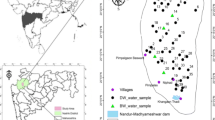Abstract
The study area Mettur forms an important industrial town situated NW of Salem district. The geology of the area is mainly composed of Archean crystalline metamorphic complexes. To identify the major process activated for controlling the groundwater chemistry an attempt has been made by collecting a total of 46 groundwater samples for two different seasons, viz., pre-monsoon and post-monsoon. The groundwater chemistry is dominated by silicate weathering and (Na + Mg) and (Cl + SO4) accounts of about 90% of cations and anions. The contribution of (Ca + Mg) and (Na + K) to total cations and HCO3 indicates the domination of silicate weathering as major sources for cations. The plot for Na to Cl indicates higher Cl in both seasons, derived from Anthropogenic (human) sources from fertilizer, road salt, human and animal waste, and industrial applications, minor representations of Na also indicates source from weathering of silicate-bearing minerals. The plot for Na/Cl to EC indicates Na released from silicate weathering process which is also supported by higher HCO3 values in both the seasons. Ion exchange process is also activated in the study area which is indicated by shifting to right in plot for Ca + Mg to SO4 + HCO3. The plot of Na-Cl to Ca + Mg-HCO3-SO4 confirms that Ca, Mg and Na concentrations in groundwater are derived from aquifer materials. Thermodynamic plot indicates that groundwater is in equilibrium with kaolinite, muscovite and chlorite minerals. Saturation index of silicate and carbonate minerals indicate oversaturation during pre-monsoon and undersaturation during post-monsoon, conforming dissolution and dilution process. In general, water chemistry is guided by complex weathering process, ion exchange along with influence of Cl ions from anthropogenic impact.
Similar content being viewed by others
References
APHA 1995 Standard methods for the examination of water and waste water (APHA).
Back W and Hanshaw B (eds) 1965 Chemical geohydrology advances in hydroscience; (Academic Press) pp. 49–109.
Cheboterev II 1955 Metamorphism of natural waters in the crust of weathering-I; Geochim. Cosmochim. Acta 8 22–48.
Elango L, Kannan R and Senthil Kumar M (2003) Major ion chemistry and identification of hydrogeochemical processes of groundwater in part of Kancheepuram district, Tamil Nadu, Indian J. Environ. Geosci. 10(4) 157–166.
Garrels R M and Christ C L 1965 Solutions minerals and equilibria; New York, Harper and Row, 450 p.
Gibbs R J 1970 Mechanisms controlling world’s water chemistry; Science 170 1088–1090.
Hem J D 1959 Study and interpretation of the chemical characteristic of natural water; USGS water supply, 269p.
Herman Bouwer 1978 Groundwater quality; Groundwater Hydrology, McGraw-Hill Kogakusha Ltd., 339–375.
Jankowski J and Acworth R I 1977 Impact of debris — flow deposits on hydrogeochemical processes and the development of dry land salinity in the Yass river catchment, New South Wales, Australia; Hydrogeol 5(4) 71–88.
Nandakumar P and Murthy D S S 1997 Irrigation related groundwater quality variations in shallow basaltic aquifer in Ghataprabha irrigation project command area, Karnataka, India — a statistical Evolution; International Conference on management of drinking water resources 223–238.
Srinivasamoorthy K 2005 Hydrogeochemistry of groundwater in Salem district, Tamil Nadu, India; Unpublished P.hD Thesis, Annamalai University, 355p.
Stallard R F, Edmond J M 1983 Geochemistry of the Amazon river. The influence of geology and weathering environment on the dissolved load; J. Geophys. Res. 88 9671–9688.
Trusdell A H and Jones B F 1973 Wateq: A computer program for calculating chemical equilibria of natural waters; J. Research USGS 2(2) 233–248.
Tamil Nadu Water and Drainage Board 2002 A profile of Tamil Nadu; unpublished Report, 503p.
Author information
Authors and Affiliations
Corresponding author
Rights and permissions
About this article
Cite this article
Srinivasamoorthy, K., Chidambaram, S., Prasanna, M.V. et al. Identification of major sources controlling groundwater chemistry from a hard rock terrain — A case study from Mettur taluk, Salem district, Tamil Nadu, India. J Earth Syst Sci 117, 49–58 (2008). https://doi.org/10.1007/s12040-008-0012-3
Received:
Revised:
Accepted:
Published:
Issue Date:
DOI: https://doi.org/10.1007/s12040-008-0012-3




